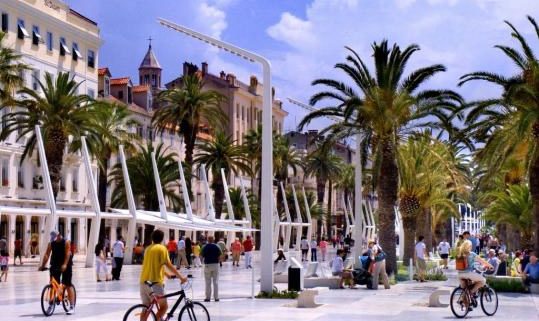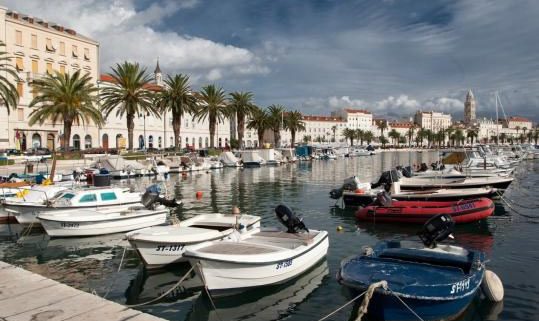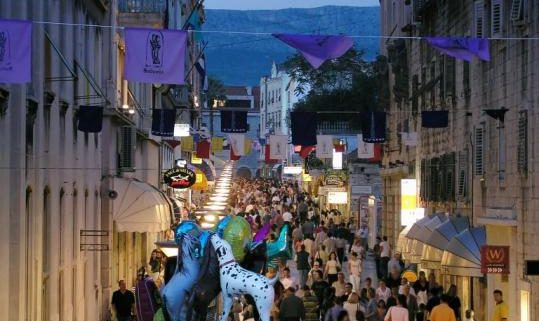OTHER ATTRACTIONS

The Riva
The Riva started to look the way it does today two centuries ago, when the French, in time of Napoleon ruled these parts through Marshal Marmont. Today this promenade is the cities living room, the most popular and most important public place in Split. In the meantime it has been widened and reconstructed several times, but it was always blessed with the most spectacular set, the south facade of the Diocletian Palace, with the entrance into the Substructures, and later on with the buildings that were built west of the Palace, also the Franciscan monastery with the church of St. Francis, and the Bajamonti Dešković Palace and last but not least the Port Authorities building on the east end.
Riva today is a pedestrian heaven, thrusting with Cafés and restaurants, an ideal place for having your morning or afternoon coffee, or for an evening out with friends over drinks. Riva is the stage of the city life of Split, a venue for numerous cultural and entertainment events, boisterous Split carnival, as well as the stage for meeting Split sportsmen after countless successes, such as Goran Ivanišević, Hajduk football club players and Jugoplastika basketball players, Olimpic medal winners… Riva is also a political forum, with decades of political opportunities being depicted through mass rallies. Naturally, Riva is always at its best in time of Sudamja, a celebration dedicated to St. Domnius, the patron saint of Split.

Matejuška port
Matejuška has been for centuries a port for small boats owned by fishermen of Split, the residents of Veli Varoš set sail from there out to the sea to feed their families. Even today there are dozens of boats tied up there, their nets drying , bait being prepared, with a monument dedicated to fishermen biding them farewell as they sail out to sea – a big fish hook.
Matejuška is also known for socializing among those who appreciate its aromas and sounds, you can always see them gathered in good spirits around a barbeque with the day’s catch on it, often also in the company of wine and song. Edo Šegvić, chronicler of Matejuška, and also the author of the reconstruction project of the port, said that Matejuška has remained, despite the growth and development of the city, the oases of preserved tradition and that it takes a special place in hearts of citizens of Split.
Among many tales from Matejuška, especially moving is the story of Roko and Cicibela, a poor fisherman and the love of his life who lived in a fishing boat, living of work from time to time and of their indestructible love. Matejuška also used to be the home of the rowing club Gusar, that bread many rowers who took off from there only to return with medals from great competitions, and in fifties and sixties that same place was a popular dancing spot. Unfortunately, it was later demolished, but life has returned to Matejuška with its new redecoration.
It is one of the most popular places today for the youth of Split, but also for their peer tourists, eager to socialise outside bars, sitting casually on sidewalks of Matejuška, usually with a drink bought in the nearby supermarket. This is what makes this old port a place where the contact between the locals and guests is most easily accomplished, to the enjoyment of either side. If someone should get hungry, many casual restaurants and taverns have opened around Matejuška, the most popular of them is the mythical Fife, attracting for years everyone who is eager to feel the spirit of the city they have chosen for their holiday.

Marmont street
Although a conqueror, Napoleon’s marshal Marmont is responsible for the urbanisation of Dalmatian cities, in return the citizens of Split have named their most beautiful street after him. Marmont street is not only beautiful but also historically meaningful. In 1922 a library and a reading room has been founded there for Francophiles, today Alliance Francaise. The first cinema of Split found its home there as well. A unique fish market decorates its centre, special because of the fact that you won’t find flies there due to the smell of sulphur which can still be felt from the neighbouring spa. It is also decorated by the beautiful Secession buildings Duplančić and Tončić, while its northern end boarders through Venetian bastion with the architecture of the Theatre and the church of Our Lady of Good Health. Two of the most popular exhibition centres in the city are also in this street, Salon Galić and the Photo Gallery. A couple of passage ways lead directly from it to Prokurative. From the Riva to the top of Marmont street numerous shops line up from right to left, turning this street into one of the most important shopping oases’ of the city centre, while the top of the street is thrusting with popular cafés and restaurants. Witty contemporary fountain, called Pirja, should not be missed! It still makes you wonder what was the message the artist was trying to convey?
